sas
1943 smock above
The Special Air Service began life in July 1941, the brainchild of  Lieutenant David Stirling of No. 8 (Guards) Commando. His idea was for small teams of parachute trained soldiers to operate behind enemy lines to gain intelligence, destroy enemy aircraft and attack
Lieutenant David Stirling of No. 8 (Guards) Commando. His idea was for small teams of parachute trained soldiers to operate behind enemy lines to gain intelligence, destroy enemy aircraft and attack  their supply and reinforcement routes. The SAS carried out this role until the end of the war serving in a number of theatres and campaigns.
their supply and reinforcement routes. The SAS carried out this role until the end of the war serving in a number of theatres and campaigns. By the end of the Second World War on 8 May 1945, the SAS had suffered 330 casualties, but had killed or wounded 7,733 and captured 23,000 of their enemies
By the end of the Second World War on 8 May 1945, the SAS had suffered 330 casualties, but had killed or wounded 7,733 and captured 23,000 of their enemies
Immediately following the conclusion of the Second World War the SAS was disbanded, however the continued necessity for a commando unit was recognised and they were reformed again in 1947. In 1950 an SAS squadron trained to be deployed in the Korean War, however they were eventually transferred to Southeast Asia to serve in the ongoing Malayan Emergency.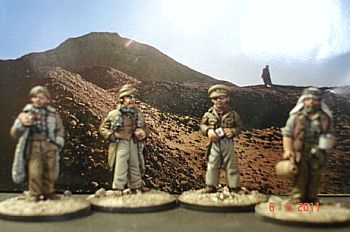 The SAS continued to serve successfully in a variety of theatres and roles throughout the Cold War, and following the September 11 attacks the SAS deployed in the 2001 invasion of Afghanistan, it has continued its diverse selection of roles to the present day.
The SAS continued to serve successfully in a variety of theatres and roles throughout the Cold War, and following the September 11 attacks the SAS deployed in the 2001 invasion of Afghanistan, it has continued its diverse selection of roles to the present day.
 The SAS continued to serve successfully in a variety of theatres and roles throughout the Cold War, and following the September 11 attacks the SAS deployed in the 2001 invasion of Afghanistan, it has continued its diverse selection of roles to the present day.
The SAS continued to serve successfully in a variety of theatres and roles throughout the Cold War, and following the September 11 attacks the SAS deployed in the 2001 invasion of Afghanistan, it has continued its diverse selection of roles to the present day.
1950s–1970s – the Cold War
Operation Helsby, February 1952, series of deep penetration operations in Malaya.Malayan Emergency
- Operation Hive
Jebel Akhdar War
- In 1958 two squadrons of 22 SAS were deployed to Oman to put down a rebellion. In January 1959 the SAS carried out a successful assault on a large guerrilla force on the Sabrina plateau.
Indonesian Confrontation
- Operation Claret, June 1964 – 1966, series of high risk cross-border patrols into Indonesia.
Aden Emergency
- "Keeni-Meeni Operations", 10 December 1963 – 1967, the search for Yemeni-trained assassins.
Dhofar Rebellion
- Operation Storm, 1970–1977, deployment of the SAS to support the Sultanate of Oman; operating under the auspices of a British Army Training Team (BATT). Included the well documented attack on the SAS outpost at Mirbat.

Lufthansa Flight 181
- Operation Feuerzauber (Fire Magic), October 18, 1977, supplemented German GSG9 commando operation.Lufthansa Flight 181 was a Boeing 737–230 Adv aircraft named Landshut,
 hijacked on 13 October 1977 by 4 militants who called themselves Commando Martyr Halime. On 18 October, the aircraft was stormed by the West German counter-terrorism group GSG 9
hijacked on 13 October 1977 by 4 militants who called themselves Commando Martyr Halime. On 18 October, the aircraft was stormed by the West German counter-terrorism group GSG 9  in Mogadishu, Somalia, and all 86 passengers rescued. The rescue operation was codenamed Feuerzauber(German term for "Fire Magic"). The objective of the hijacking was to secure the release of imprisoned Red Army Factionleaders and is considered to be part of the German Autumn.
in Mogadishu, Somalia, and all 86 passengers rescued. The rescue operation was codenamed Feuerzauber(German term for "Fire Magic"). The objective of the hijacking was to secure the release of imprisoned Red Army Factionleaders and is considered to be part of the German Autumn.
1980s–1990s
Iranian Embassy Siege
- Operation Nimrod,
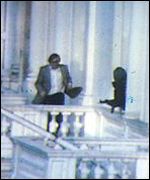 5 May 1980, successful rescue of hostages from the Iranian embassy in London.
5 May 1980, successful rescue of hostages from the Iranian embassy in London.
Falklands War
- Operation Corporate, 2 April-14 June 1982, the overall British operation to recover the Falkland Islands. The SAS alongside the SBS carried out numerous reconnaissance missions and diversionary raids in East and West Falkland to support the campaign. SAS forward observers also directed British artillery and aircraft
- Operation Paraquet, 25 April 1982, successful recapture of the Island of South Georgia.
- Pebble Island Raid,
 14–15 May 1982, successful attack on Argentinian-held airbase in West Falkland.
14–15 May 1982, successful attack on Argentinian-held airbase in West Falkland.
- Operation Sutton, 21–23 May 1982, landings in East Falkland.

- Operation Mikado, May 1982, abortive operation to destroy the three remaining Exocet missiles in Argentine possession.
- Mount Kent, 29–31 May 1982, D Squadron of 22 SAS seized and then held the vital Mount Kent high ground for three nights against repeated Argentine assaults until being reinforced by 42 Commando.
The Troubles
- Operation Banner, 1969-1997, deployment of the British army in Northern Ireland, the official SAS deployment from 1976.
- M60 gang, 1980, eight IRA members arrested, SAS Captain Herbert Westmacott killed.
- Loughgall,
 1987, ambush of eight IRA members.
1987, ambush of eight IRA members. - Flavious,
 1988, operation against three IRA members in Gibraltar.[15]
1988, operation against three IRA members in Gibraltar.[15] - Coagh, 1991,
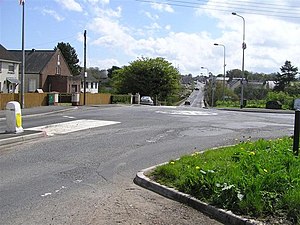 ambush of three IRA members.
ambush of three IRA members. - Clonoe,
 1992, ambush of six IRA members.
1992, ambush of six IRA members. - Coalisland, 1997, one alleged IRA member shot and wounded after a grenade attack on RUC barracks.
Gulf War
Bosnian WarOperation Granby, January 1991, the deployment British forces during the Gulf War, the SAS component included the welldocumented Bravo Two Zero patrol. The SAS adopted its classic deep penertration role behind enemy lines, being deployed in numerous reconnaissance missions and raids on Scud launchers and communications sites. They also acted as observers for Coalition artillery and aircraft.
- Operation Victor Two, February 1991, a successful assault on a Scud communications installation.
- Operation Joint Endeavor, 16 July 1992 – 2 December 2004, NATO intervention in Bosnia and Herzegovina.
- Operation Tango, 10 July 1997, the arrest of two suspected war criminals.
- Operation Ensue, November 1998, the arrest of a Serbian War criminal.
Japanese embassy hostage crisis
- Operation Chavín de Huántar, 22 April 1997, supplemented Peruvian Army operation
2000s–2010s – the War on Terror[edit]
Sierra Leone Civil War
- Operation Palliser, May 2000, deployment of British forces in Sierra Leone.
- Operation Barras, 10 September 2000, rescue of 6 captured members of the Royal Irish Regiment in Sierra Leone.The United Kingdom began a military intervention in Sierra Leone in May 2000 under the codename Operation Palliser. Although small numbers of British personnel had been deployed previously, Palliser was the first large-scale intervention by British forces in the Sierra Leone Civil War.
In early May 2000, the Revolutionary United Front (RUF)—one of the main parties to the civil war—advanced on the country's capital, Freetown
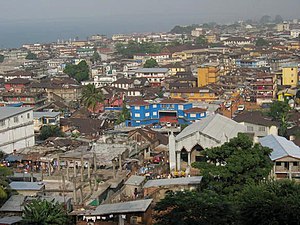 , prompting the British government to dispatch an "operational reconnaissance and liaison team" (ORLT) to prepare to evacuate foreign citizens. On 6 May, the RUF blocked the road connecting Freetown to the country's main airport, Lungi. The next day, British soldiers began to secure the airport and other areas essential to an evacuation. The majority of those who wished to leave were evacuated within the first two days of the operation, but many chose to stay following the arrival of British forces.
, prompting the British government to dispatch an "operational reconnaissance and liaison team" (ORLT) to prepare to evacuate foreign citizens. On 6 May, the RUF blocked the road connecting Freetown to the country's main airport, Lungi. The next day, British soldiers began to secure the airport and other areas essential to an evacuation. The majority of those who wished to leave were evacuated within the first two days of the operation, but many chose to stay following the arrival of British forces.
- Operation Barras, 10 September 2000, rescue of 6 captured members of the Royal Irish Regiment in Sierra Leone.The United Kingdom began a military intervention in Sierra Leone in May 2000 under the codename Operation Palliser. Although small numbers of British personnel had been deployed previously, Palliser was the first large-scale intervention by British forces in the Sierra Leone Civil War.
War in Afghanistan
- Operation Enduring Freedom, 7 October 2001–ongoing, NATO deployment in Afghanistan. The SAS were involved in the initial invasion and remain actively involved in the conflict.
- Operation Trent, November 2001, attack on an Al Qaeda opium plant and command centre.
- Tora Bora, 12–17 December 2001, failed attempt to capture Osama Bin Laden.
- Operation Condor, May 2002.
- Rescue of Stephen Farrell, 9 September 2009, successful SAS-SBS operation to rescue Times journalist Stephen Farrell
 after he was captured by the Taliban.
after he was captured by the Taliban. - Operation Moshtarak, March 2010, a part of a U.S.-led operation in Helmand Province, operating with Navy SEALs striking against and capturing Taliban leaders.

- Rescue of Helen Johnston, July 2012, SAS conducted and led a joint operation with American Delta Force in a night time raid in the Shahr-e-Bozorg district, in a large forested area near the Tajikistan
 border called Koh-e-Laran. SAS and Delta Force arrived by helicopter and undertook a "long march" to a cave system where 4 aid workers (1 British, 1 Kenyan, 2 Afghan) were being held. There was a moment of alarm when the US troops reported that the cave they assaulted did not contain any hostages. The tension was broken when the SAS commander on the ground reported that his team had successfully rescued all four hostages and killed 11 kidnappers within minutes. There were no SAS fatalities or injuries.
border called Koh-e-Laran. SAS and Delta Force arrived by helicopter and undertook a "long march" to a cave system where 4 aid workers (1 British, 1 Kenyan, 2 Afghan) were being held. There was a moment of alarm when the US troops reported that the cave they assaulted did not contain any hostages. The tension was broken when the SAS commander on the ground reported that his team had successfully rescued all four hostages and killed 11 kidnappers within minutes. There were no SAS fatalities or injuries.
Iraq War
- Operation Telic, 19 March 2003 – 30 April 2009, the British deployment in Iraq. It is not clear whether the SAS were involved in the 2003 Invasion of Iraq, however they were involved in later operations during the occupation.
- Operation Row, 18 March 2003, the Daily Mail alleged in February 2013 that the SAS were deployed in Iraq two days before the Coalition invasion, in an operation named "Row" to destroy scud launchers. B & D Squadrons of 22 SAS were tasked to assault the town of Al Qa’im in Northwest Iraq where it was believed chemical weapons were ready to be deployed.
- Basra prison incident, 2005, two undercover Special Air Service soldiers were captured by Iraqi police after it was alleged they opened fire on a police check point. The British army used tanks to encircle the building they were being held and after nightfall the SAS stormed the prison and rescued the captured operatives. According to the governor of Basra province, Mohammed al-Waili, the British had used "more than ten tanks backed by helicopters" to carry out the raid. After the British army left, around 150 other prisoners fled the prison.
- On 25 December 2006, the SAS again raided the Al Jameat station, killing seven gunmen and freeing 127 prisoners being held by Shia militias there. They then blew up the building.
- A British Army spokesperson stated that the 127 prisoners freed had been tortured and that there were fears that they were about to be executed.
- Task Force Black, 2005-2008, an SAS team worked jointly with American Delta Force as a unit known as "Task Force Black" in a secret war against Al Qaeda and other insurgents based in Iraq. The "Black Ops" operation claimed to have cleared 3,500 insurgents off the streets with "several hundred" of them believed to have been killed. 6 SAS soldiers had also been killed and 30 injured in the Operation.
- General Stanley McChrystal,
 the American commander of NATO forces in Iraq, has commented on A Squadron 22 SAS Regiment; that when part of Task Force Black and Task Force Knight, carried out 175 combat missions during a six-month tour of duty.
the American commander of NATO forces in Iraq, has commented on A Squadron 22 SAS Regiment; that when part of Task Force Black and Task Force Knight, carried out 175 combat missions during a six-month tour of duty.- Operation Marlborough, July 2005, SAS sniper teams of Task Force Black killed 3 insurgents.
- Christian Peacemaker hostage crisis, 23 March 2006, SAS-led operation as part of Task Force Black to free British and Canadian peace activists.
- On 6 September 2007, a 30-man SAS team of Task Force Black assaulted a house that intel had pinpointed as the location of a senior Al-Qaeda figure. The mission was a success but it cost the life of one of the SAS servicemen.
- 2011 military intervention in Libya, an early operation was conducted by E-Squadron of UK special forces; consisting of elements from the SAS, SBS and MI6.[35] This was to contact the Libyan rebel and opposition leaders, however the mission was a failure after the team was captured and held prisoner for 72 hours by Libyan rebels
- Operation Ellamy, a BBC news broadcast on 19 Jan 2012 revealed that the SAS had, in fact been redeployed to Libya as part of the larger British deployment, in a joint operation with French and Qatari special forces. The programme explained that 22 SAS were in the East of Libya, operating in small groups in places like Misrata and
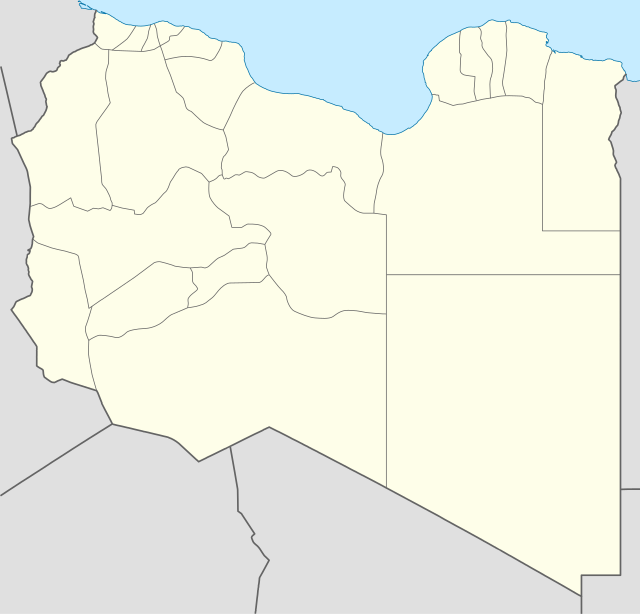 Brega by August. They assisted in training, coordinating and commanding opposition groups on and off the front line, and they were very active directing NATO airstrikes. It was also alleged that 22 SAS were leading the hunt for Gaddafi after the Battle of Tripoli.
Brega by August. They assisted in training, coordinating and commanding opposition groups on and off the front line, and they were very active directing NATO airstrikes. It was also alleged that 22 SAS were leading the hunt for Gaddafi after the Battle of Tripoli.
- Operation Ellamy, a BBC news broadcast on 19 Jan 2012 revealed that the SAS had, in fact been redeployed to Libya as part of the larger British deployment, in a joint operation with French and Qatari special forces. The programme explained that 22 SAS were in the East of Libya, operating in small groups in places like Misrata and
Military intervention against the Islamic State of Iraq and the Levant
- Operation Shader,In August 2014, the SAS were reported to be on the ground gathering intelligence and helping with the evacuation of Yazidi refugees from the Sinjar mountains[
At least one full squadron have been deployed to Iraq.and have reportedly been helping Kurdish forces in northern Iraq



No comments:
Post a Comment